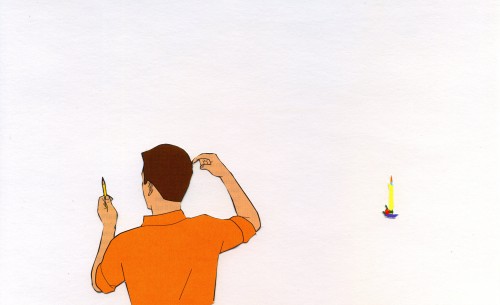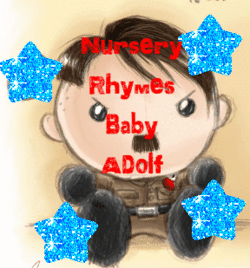Why would anyone want to write, read, or listen to someone read out loud a “piece of fiction,” let alone a fucking poem?
Why would anyone want to write, read, or listen to someone read out loud a “piece of fiction,” let alone a fucking poem?
Personally, I have never written any fiction, and I don’t plan on starting any time soon.
Some habits are naturally addictive, like smoking cigarettes or eating large bags of Kettle chips, and other habits are only willfully, stubbornly repeated–one of these is sitting down and trying to write “interesting” sentences to create “literary art.”
“Gorgeous and Horrific Feelings”: A Review of Lasky’s Thunderbird
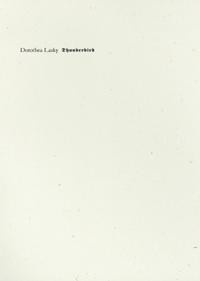 Thunderbird
Thunderbird
by Dorothea Lasky
Wave Books, October 2012
128 pages / $16 Buy from Wave Books or SPD
Dorothea Lasky’s third poetry collection, Thunderbird, begins with the lines “Baby of air / You rose into the mystical / Side of things”—which immediately prompted me to hum Van Morrison’s “Into the Mystic.” It wasn’t a great start to reading this book, but what I realized was that it wasn’t the word “mystical” that brought a song to mind so much as it was the lyricism of Lasky’s writing. As I hummed on, I recognized that the language of “Baby of Air” works through patterns, creating emotion tenor through lines that build on each other. A few lines later, Lasky writes, “People cannot keep air in / I blow air in / I cannot keep it in.” These lines are not typical, flowing lyrics packed with sound play, but are instead a series of seemingly simple phrases that amass meaning through repetition. At times, Lasky’s lyricism even has a blues-like effect in lines like “O you are already there / O you are already there / My brother tells me, you are already there.” Even in this opening piece, poetic lyricism and song come together to form both voice and emotional resonance to carry the reader through the rest of the collection.
However, Lasky’s language does not end at simple repetition. Mixed with this lyric quality (and sometimes at odds with it) are straightforward statements that strike the reader through their baring of the intimate. At times, this approach takes on the negative association of confessionalism—the self-indulgent statement of personal emotion that shuts out the reader—however, at Lasky’s best she filters this private emotion through straightforward statement, creating for the reader a realistic portrayal of human (universal) feeling.
December 21st, 2012 / 12:00 pm
collages and blood: literary criticism
The following post consists of two things:
- Collages I’ve made on 5×8″ index cards over the past year and a half
- Paper towels and tissues I’ve used to stop myself from bleeding, the result of pulling off hangnails while sitting in front of a computer
I view this as an example of literary criticism (feel free to do otherwise).
250 Points: The Hobbit, or, As Expected, a Bogus Journey
- I really, really hated Peter Jackson’s Lord of the Rings films. I think it only fair I get that out there, right up front.
- Why did I hate them so very much?
- Well, it’s complicated.
25 Points: Infinite Jest
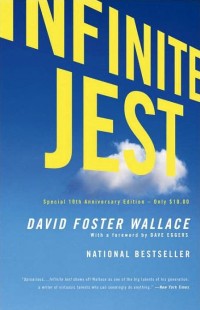 Infinite Jest
Infinite Jest
by David Foster Wallace
Little, Brown, 1996
1104 pages / $17.99 buy from Powell’s
1. David Foster Wallace was born in a small town in western Ohio, best known for its jar factory. This would figure in the book, Infinite Jest.
2. The first three pages of Infinite Jest are like a key to the novel. Without them you’ll probably be lost.
3. A palm tree is a recurring motif in the book, which seems to represent an opening and closing of the author’s heart.
4. DFW first wrote the manuscript to Infinite Jest when he was 22. He put it in a box that he carried from apartment to apartment as he studied at various schools or followed various women about the country.
5. By the third chapter, with the introduction of the character of the cabbie, you’ll probably feel confused and even ready to give up. Most people do right here.
6. Infinite Jest will seem like the driest book you’ve ever read. DFW needed to wring out the wet in literature.
7. A capable reader will read 22 pages at a time. Don’t worry if you aren’t capable. Most of us won’t be.
8. DFW refound the manuscript of Infinite Jest at age 33, when he was moving out of the house near Tulsa. He didn’t think much of it, apparently.
9. In a survey of college students, most readers found themselves skipping an average of 2 pages every 10.
10. At one point, the cabbie finds a note from his wife. This seems to represent a fracturing of the potency of language. READ MORE >
December 20th, 2012 / 9:09 am
Announcing the Most Terrifically Tyrannical Poetry Collection of 2012
Early this morning, in the wee wee hours, a group of glamorous/ghastly ghosts (including the first wife of British bard Ted Hughes) convened to determine the Most Terrifically Tyrannical Poetry Collection of 2012. After numerous gulps of grape Juicy Juice and some suicide threats the superstar sprites concluded that Baby Adolf’s Nursery Rhymes warranted the wonderful honor.
Congratulations Baby Adolf!
Why Down These Mean Streets Matters Now More Than Ever
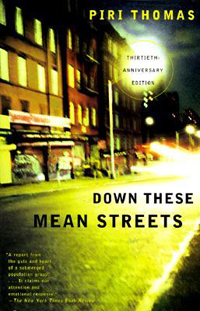 Down These Mean Streets
Down These Mean Streets
by Piri Thomas
First published 1967, Knopf.
Vintage Edition, 1997
352 pages / $14.95 Buy from Amazon
In the essay “The Simple Art of Murder” for The Atlantic Monthly in 1945, noir author Raymond Chandler wrote “Down these mean streets a man must go who is not himself mean, who is neither tarnished nor afraid.” While Chandler was speaking about detectives in novels, the same could easily be said about youth growing up in inner city neighborhoods. The first person publicly known to make the connection was Knopf editor Angus Cameron, who paraphrased this on a manuscript he was given titled “Home Sweet Harlem” by a man named Piri Thomas. The manuscript, which was published by Knopf in 1967, would become known as Down These Mean Streets.
In May of that year, critic Daniel Stern of The New York Times reviewed the memoir, saying, “It is something of a linguistic event. Gutter language, Spanish imagery and personal poets…mingle into a kind of individual statement that has very much its own sound…” Little did Stern realize that so-called “gutter language” would have such an impact on contemporary literature. Subsequently the novel was later banned in multiple school districts across the country (including District 25 in Queens, New York) on the basis of obscenity.
The ban in Queens was not lifted until five years later, even after it was brought to court by the New York Civil Liberties Union.
Published several years after Claude Brown’s Manchild in the Promised Land, (which unlike Thomas’ memoir is an autobiographical novel) the book was marketed using language akin to the sensationalism of most modern tabloids, as any reader can see on the front and back covers of Signet’s 1968 reprint. Phrases such as “savage power” and “the brutal code of machismo” plainly indicate a widespread culture of ignorance. Thus was the attitude of publishers about works based on the experiences of people of color in 1968. Whether much has changed in the publishing industry’s attitudes about urban literature now is an entirely different discussion.
December 19th, 2012 / 12:00 pm
Holiday Shopping Guide: Poetry Recommendations

Since I did a Nonfiction Shopping Guide and a Fiction Shopping Guide, it seems only fair to offer a Poetry Shopping Guide as well.
Same guidelines apply here as with the other two: 20 titles published in 2012, randomly arranged, omitting publications by HTMLGIANT crew, and skewed toward my own aesthetic interests.
Without further adieu…
25 Points: Woes of the True Policeman
 Woes of the True Policeman
Woes of the True Policeman
by Roberto Bolaño
Farrar, Straus and Giroux, 2012
256 pages / $25.00 buy from Amazon
1. I don’t want to believe this is a draft of works that were to come later.
2. And yet its opening section appears word-for-word in The Savage Detectives.
3. I’ve read over and over that Bolaño worked on this book from the 1980s up to his death in 2003. The endnote (which comes abruptly) suggests he was serious enough about it to have revised a couple of times by hand, on an electric typewriter, and on a computer. There were also two physical manuscript versions. Parts of all of these were pieced together to create this book. This corresponds with other accounts of trying to bring his posthumous work into order. I remember reading somewhere that he first wrote the name “Arcimboldi” in the late 1980s.
4. Reading that distressed me. All I could think about on the way to work later, looking at the sidewalk, was whether whoever wrote that had meant “Arcimboldi” or “Archimboldi.”
5. In 2666, we get the life story of Benno von Archimboldi, whom no one in the literary world has ever seen, and to the search for whom the entire first section is devoted. The Critics read his books constantly, sometimes over and over again as if they’re becoming ill or desperate, but with the exception of the book that makes Lotte Reiter realize that Archimboldi is her brother, we don’t get much of an idea of the novels’ content. He is a giant pacing around in the desert, upsetting animals and stones and cacti with his footfalls’ vibrations.
6. A whole section of Woes is devoted to the works and certain biographical details (friendships, hobbies, epistolary relationships, feuds) of J.M.G. Arcimboldi. One oblique reference to his disappearance is made in the book. But he is still overwhelmingly the man who’s not there.
7. I’ve drawn out the same triangle over and over again: Benno von Archimboldi–J.M.G. Arcimboldi–J.M.G. Arcimboldi (Savage Detectives). Then I stare at it, scratch my chin or suck at coffee, and wonder: what does “J.M.G” stand for? why drop the “h” (or add the “h”?)? are the two Arcimboldis the same?–only The Endless Rose appears in both of their bibliographies–is this a play on the fact that Italian artist seems to have gone by Arcimboldo and Arcimboldi? and, for that matter, is there any real connection to the painter? the fragmented man? the man made of whatever can be gleaned from the world around him? Why are the Arcimboldis French, and Archimboldi is a Prussian who writes novels that are distinctly French, Polish, and American?
8. Then there’s Lalo Cura, to whom I had been imagining the title referred to since I first saw it. He has a “prefiguration” in a short story: the child of a porn actress who later sees his mother’s work and imagines himself in the womb, cocks pressed up against his sealed-shut eyes. He grew up in Los Empalados (The Impaled). Seems like his father might have been Lacroix from By Night in Chile. He isn’t a policeman. The other two Lalo Curas are.
9. But they’re not even both Lalo Cura; one is Pancho Monje. The Madness and the Monk. Both are the product of five generations of Maria Expósitos of Villaviciosa, who are raped and then give birth to another Maria Expósito, until a son, whose father “was the devil,” kills his sister’s rapist. Then the next Maria Expósito learns to read and write, and is seduced by two (or three) students out in the desert. They are French in this book. They might be Belano and Lima in 2666. Regardless; rape in Villaviciosa creates a continuum; murder writes history.
10. I was in the labyrinthine aisle of beverage refrigerators in Mardi Gras Zone late the other night. It was maybe two in the morning, I don’t remember; I was pretty fried from work. But I see a big dark bottle on a low shelf that says “Villaviciosa” on the label, and my heart slips out of gear. It’s some kind of apple cider. But it’s from Spain. There is no Villaviciosa in Sonora. There’s a fleck on the map called Villaviciosa in Chiapas, near the Guatemalan border. I learned from a website in Spanish that it has an altitude of 780 (meters? feet?) and 5 inhabitants. I don’t speak Spanish. But the meaning of “Villaviciosa” is pretty clear. READ MORE >
December 18th, 2012 / 6:15 pm



